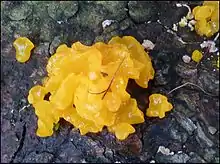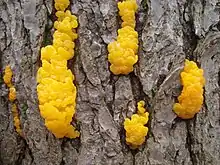| Dacrymyces chrysospermus | |
|---|---|
 | |
| Dacrymyces chrysospermus, Ontario, Canada | |
| Scientific classification | |
| Domain: | Eukaryota |
| Kingdom: | Fungi |
| Division: | Basidiomycota |
| Class: | Dacrymycetes |
| Order: | Dacrymycetales |
| Family: | Dacrymycetaceae |
| Genus: | Dacrymyces |
| Species: | D. chrysospermus |
| Binomial name | |
| Dacrymyces chrysospermus Berk. & M.A.Curtis (1873) | |
| Synonyms | |
| |
Dacrymyces chrysospermus is a species of jelly fungus in the family Dacrymycetaceae. In the UK it has the recommended English name of orange jelly spot;[1] in North America it is known as orange jelly or orange witch's butter.[2] The species is saprotrophic and grows on dead coniferous wood. Basidiocarps are gelatinous, bright orange, and extremely variable in shape, but typically stoutly stipitate with a spoon- or cup-shaped, spore-bearing head. They are frequently erumpent in groups, often coalescing to form complex masses up to 6 cm (2.4 in) across.[3] Dacrymyces chrysospermus was originally described from New England, but is said to have a worldwide distribution.[3] Microscopically it is distinguished from most other species of Dacrymyces by its comparatively large (18–23 by 6.5–8 µm), 7-septate basidiospores.[3][4]

References
- ↑ Holden L. (April 2022). "English names for fungi 2022". British Mycological Society. Retrieved 1 November 2022.
- ↑ Emberger, Gary. "Dacrymyces chrysospermus". Fungi Growing on Wood. Messiah College Oakes Museum. Retrieved 1 November 2022.
- 1 2 3 McNabb, RF (1973). "Taxonomic studies in the Dacrymycetaceae: VIII. Dacrymyces Nees ex Fries". New Zealand Journal of Botany. 11 (3): 461–524. doi:10.1080/0028825X.1973.10430296.
- ↑ O'Reilly, Pat. "Dacrymyces chrysospermus". First Nature. Retrieved 1 November 2022.